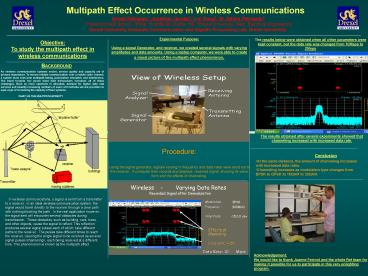Multipath Effect Occurrence in Wireless Communications - PowerPoint PPT Presentation
1 / 1
Title:
Multipath Effect Occurrence in Wireless Communications
Description:
Annah Ndirangu1, Jonathan Jacobs2, Lun Dong3, Dr. Athina Petropulu3 ... Using a signal Generator, and receiver, we created several signals with varying ... – PowerPoint PPT presentation
Number of Views:236
Avg rating:3.0/5.0
Title: Multipath Effect Occurrence in Wireless Communications
1
Multipath Effect Occurrence in Wireless
Communications
Annah Ndirangu1, Jonathan Jacobs2, Lun Dong3, Dr.
Athina Petropulu3 1Frankford High School, 2Phila.
YouthBuild Charter HS, 3Drexel University, Dept.
Electrical Engineering Drexel University Graduate
Communication and Signals Processing Lab, Drexel
University.
Experimental Purpose Using a signal Generator,
and receiver, we created several signals with
varying amplitudes and data amounts. Using a
laptop computer, we were able to create a visual
picture of the multipath effect phenomenon.
The results below were obtained when all other
parameters were kept constant, but the data rate
was changed from 10Msps to 2Msps
Objective To study the multipath effect in
wireless communications
BACKGROUND
As wireless communication systems evolve, service
quality and capacity are of primary importance.
To ensure reliable communication over a mobile
radio channel, a system must overcome multipath
fading, polarization mismatch, and interference.
The trend towards low power hand held
transceivers increases all of these challenges.
Even as more spectrum is allocated, demand for
higher data rate services and steadily increasing
numbers of users will motivate service providers
to seek ways of increasing the capacity of their
systems. WHAT US THE
MULTIPATH EFFECT?
The results obtained after several experiments
showed that channeling increased with increased
data rate.
Procedure Using the signal generator, signals
varying in frequency and data rates were send out
to the receiver. A computer then records and
displays received signal, showing its wave form
and the effects of channeling.
Conclusion
- At the same distance, the amount of channeling
increases with increased data rates. - Channeling increases as modulation type changes
from BPSK to QPSK to 16QAM to 32QAM.
RESULTS
In wireless communications, a signal is sent
from a transmitter to a receiver. In an ideal
wireless communication system, the signal would
travel directly to the receiver through a clear
path with nothing blocking the path. In the real
application however, the signal sent will
encounter several obstacles during transmission.
These obstacles, such as building, cars, trees,
and other objects, cause the signal to reflect.
This reflection produces several signal pulses
each of which take different paths to the
receiver. The pulses take different times to
reach the receiver, causing the single signal to
be received as several signal pulsesltchannelinggt,
each being received at a different time. This
phenomenon is known as the multipath effect.
Acknowledgement We would like to thank Joanne
Ferroni and the whole Ret team for making it
possible for us to participate in this very
enlighting program.































